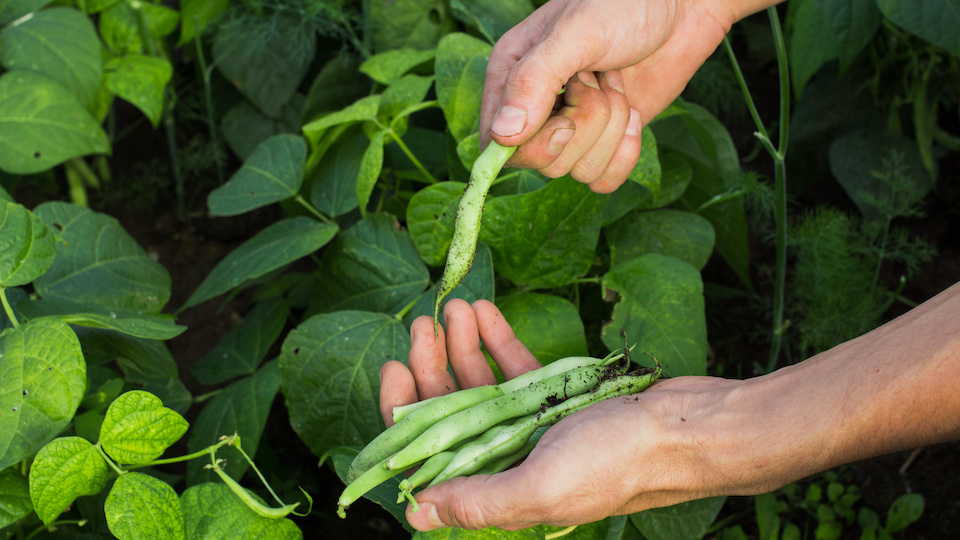Beans are a staple crop in home gardens around the world. They are robust, easy to start, and a delicious garden vegetable that can be canned and preserved for later enjoyment. But have you ever wondered if there was anything that you could do to maximize your bean plant’s performance and increase your yield? In fact, there are some really easy, time-tested tricks that can help you have a huge harvest of your favorite beans.
Before I get into the best ways to maximize your bean harvest, let’s take a closer look at the different types of garden beans.
Bush Beans
Bush beans grow and mature quickly and are a fabulous filler crop to include in your garden. These plants are also determinate in nature, meaning that they don’t continually produce but put off most of their fruit in a shorter period than other types of beans. Bush beans are compact and are at home in any garden and even containers.
Pole Beans
Although pole beans take longer to mature and produce more fruit than bush beans, once they start, they don’t stop – producing loads of beans all season long. This is because most varieties are indeterminate in nature, growing the entire season. Pole beans work great in small gardens because they can be trained to a trellis, taking up little space and bringing great vertical interest.
Snap, Shelling, and Dry Beans
Beans are further divided into three categories including snap, shelling, or dry beans. Some types of beans can fall into all of these categories. It all depends on when you harvest. A good example is Scarlett Runner beans that are delicious as a fresh snap harvest young but can also be left to mature on the vine, turning into delicious dry storage beans.
The typical green bean is a snap bean which just means that you eat the whole bean, including the pod. When picked at the right time, snap beans are tender and crunchy, not tough and dry. Some great varieties to try include, Dragon Tongue, Provide, and Royal Burgandy.
Shelling beans require the pod to be removed before consumption. Examples include lima and soybeans. Dry beans are left to mature completely ( like the Scarlett Runner above) until the inner bean is dry and hard. Once the pod is taken off, the beans are easy to store and keep for a long time. My favorite types include black beans, kidney beans, and pinto beans.
How to have a massive bean harvest
Beans are a perfect crop for first-time gardeners. They are super easy to start (you have probably started a bean seed between wet paper towels before) and don’t require much upkeep. However, ever since I discovered a few simple tricks, my bean plant production has been off the charts, year after year!
Start beans in biodegradable pots
Although you may not think it matters much, starting bean seeds a month or so before your last expected frost in biodegradable pots can make a huge difference to plant health and production. Of course, if you have a long growing season, the best thing to do is direct sow beans but for those who want to get a jump start on the season. Bean plants don’t like to have their roots messed with, and transplanting seedlings from starter trays can hamper plant health. Using a biodegradable starter pot (one per bean seed), you can plant the entire thing into the garden without disturbing plant roots. My experience is that bean plants with undisturbed roots produce far better than those that have been handled and transplanted.
Mulch, mulch, and mulch
After seedlings emerge, or when you plant your early started plants, provide at least two inches of organic mulch. Mulch helps to retain moisture in the soil and keep plant roots cool. In my experience, plants without mulch often lose their blossoms during periods of heat and drought, and this equates to fewer beans.
Work in some compost
Beans are light feeders, not really requiring constant feeding during the growing season like some other plants. This is good news for the gardener who is short on time. However, an excellent practice is to work in 3 inches of aged compost into the soil before planting your bean patch. This compost adds a good nutritional boost for young plants and helps to improve soil structure, allowing for strong root development and bean production.
Regular irrigation
For best production, beans need regular irrigation during the entire growing season. A lack of water can squash production and produce beans that lack flavor. Mulching helps retain moisture, but you must provide regular water during and after flowering, especially to ensure a good harvest of tasty beans. One of my favorite ways to keep beans happy, healthy, and producing, is to install a drip irrigation system that ensures regular water is being delivered.
Temperature matters
Although bean plants are hardy, to get the biggest harvest possible, pay attention to both the air temperature and the soil temperature. Beans like to be planted when the soil temperature is 60 degrees F or above and do best when the air temperature is between 70 degrees and 80 degrees F.
Do these five things, and your plants will reward you with a huge harvest!
Happy Growing!
-Susan Patterson, CBHC and Master Gardener




